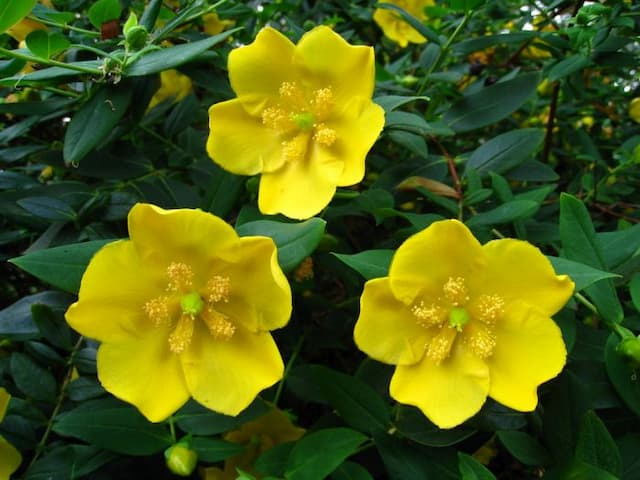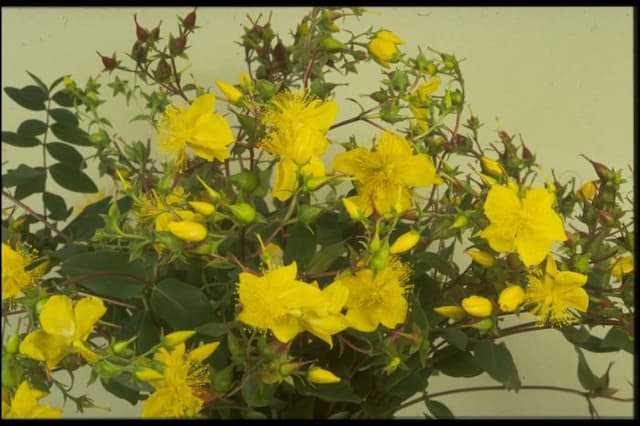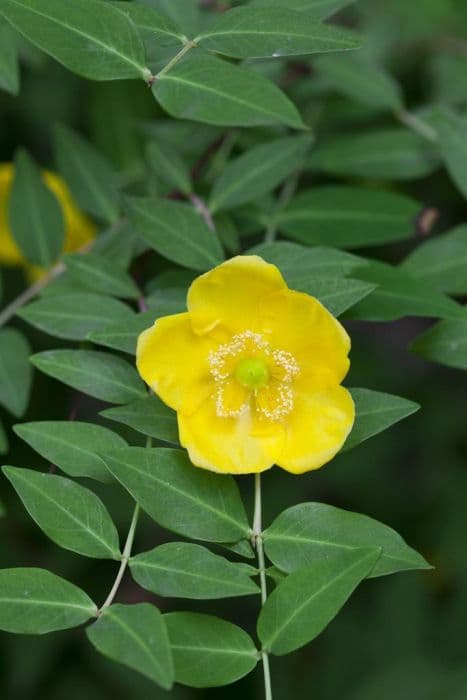Egyptian St John's Wort Hypericum aegypticum

ABOUT
Hypericum aegypticum, commonly known as Egyptian St. John's Wort, is a distinctive plant that exhibits a bushy growth form. Typically found in warmer climates, this species has numerous stems that give the plant a dense, shrubby appearance. The foliage consists of small, blue-green leaves that are narrow and oblong-shaped, presenting a slightly leathery texture and appearing opposite each other on the stems. This foliage arrangement provides a lush, crowded look to the plant. The Egyptian St. John's Wort blossoms with bright yellow flowers that are a defining feature of the genus Hypericum. These blooms possess a profusion of stamens, which are the small, threadlike structures emerging from the flower's center, lending each blossom a fluffy, tufted look that is visually striking. The flowers are typically characterized by their five-petaled symmetry and the presence of dark, glandular spots along the petal margins, which add to their ornamental appeal. The plant's overall impression is one of a vibrant, yellow-flowered shrub with a full, robust presence. Its blue-green leaves contrast sharply with the golden hue of the blossoms, creating an attractive tapestry of color that can enliven naturalistic landscapes and cultivated garden settings. The Egyptian St. John's Wort bears a sense of the Mediterranean in its appearance, fitting for a plant whose common name references the ancient land of Egypt.
About this plant
 Names
NamesFamily
Hypericaceae
Synonyms
Egyptian St. John's Wort, Golden St. John's Wort
Common names
Hypericum webbii, Hypericum lanuginosum, Hypericum tomentosum.
 Toxicity
ToxicityTo humans
Hypericum aegypticum, commonly known as St. John's Wort, contains hypericin, which can cause photodermatitis when ingested in significant quantities. While it’s not extremely toxic to humans, consuming large amounts can lead to symptoms like gastrointestinal distress (nausea, vomiting, diarrhea), fatigue, dizziness, confusion, and photosensitivity, which can increase the risk of sunburns and skin irritation when exposed to sunlight. Care should be taken to avoid ingesting this plant and to consult a medical professional if ingested.
To pets
St. John's Wort, or Hypericum aegypticum, can be toxic to pets, particularly to grazing animals like horses and cows, although dogs and cats are usually less likely to ingest it. If pets consume significant amounts of this plant, they may experience photosensitization, which leads to skin issues when the animal is exposed to sunlight, such as dermatitis or sunburn. There might also be gastrointestinal upset, with symptoms including vomiting and diarrhea. If a pet has ingested St. John's Wort, it is important to contact a veterinarian to seek appropriate care.
 Characteristics
CharacteristicsLife cycle
Perennials
Foliage type
Evergreen
Color of leaves
Green
Flower color
Yellow
Height
1-2 feet (30-60 cm)
Spread
1-2 feet (30-60 cm)
Plant type
Shrub
Hardiness zones
8
Native area
Mediterranean
Benefits
 General Benefits
General Benefits- Ornamental value: Hypericum aegypticum, also known as Egyptian St John's Wort, has bright yellow flowers that can add aesthetic beauty to gardens and landscapes.
- Drought resistance: This species is well-adapted to dry conditions, making it suitable for xeriscaping or gardens in arid regions.
- Soil improvement: It can help stabilize soil and prevent erosion due to its root system.
- Pollinator attraction: The flowers of Egyptian St John's Wort attract bees and other pollinators, supporting biodiversity.
- Low maintenance: It generally requires minimal care once established, making it a practical choice for low-maintenance gardens.
 Medical Properties
Medical Properties- Antidepressant: Hypericum aegypticum, commonly known as Egyptian St. John's Wort, is related to Hypericum perforatum, which is widely used for its antidepressant activity due to the presence of hypericin.
- Antimicrobial: It is believed to have antibacterial and antiviral properties, which may help in fighting off infections.
- Anti-inflammatory: The plant is traditionally used for its anti-inflammatory effects, potentially assisting in the reduction of inflammation in the body.
- Healing of wounds: There is a historical use of the plant in promoting the healing of wounds and burns.
- Antioxidant: The presence of phenolic compounds in Hypericum species suggests that it may have antioxidant capabilities.
 Air-purifying Qualities
Air-purifying QualitiesThis plant is not specifically known for air purifying qualities.
 Other Uses
Other Uses- Hypericum aegypticum, also known as Coastal St. John's Wort, can be used as a natural dye, giving fabrics a range of colors from yellow to deep red depending on the mordant used.
- The plant can serve as an ornamental addition to gardens due to its bright yellow flowers that bloom in the summer months.
- The essential oils from Coastal St. John's Wort can be used in the fragrance industry for creating perfumes with a unique scent.
- The flowers can be used in the preparation of herbal teas, which impart unique flavors and are enjoyed for their aromatic qualities.
- Leaves of the plant can be integrated into the craft of potpourri, providing a pleasant aroma and visual appeal to the mix.
- Flowering shoots of Coastal St. John's Wort can be incorporated into floral arrangements and bouquets for their vibrant color and longevity.
- In eco-printing, a technique where plants are used to print images on paper or fabric, the leaves and flowers of this plant can impart interesting patterns and colors.
- The plant has been used in certain cultures for spiritual or ritualistic purposes, such as warding off evil spirits or as part of ceremonies.
- Coastal St. John's Wort's dense growth habit can help in soil erosion control, making it useful in coastal and desert garden landscaping.
- The plant can provide habitat and food for various insects and pollinators, enhancing local biodiversity in the areas where it is grown.
Interesting Facts
 Feng Shui
Feng ShuiThe plant Hypericum is not used in Feng Shui practice.
 Zodiac Sign Compitability
Zodiac Sign CompitabilityThe Hypericum is not used in astrology practice.
 Plant Symbolism
Plant Symbolism- Protection: Commonly known as St. John’s Wort, Hypericum aegypticum has been associated with warding off evil spirits and protective qualities. Traditionally, it was believed to have magical powers that could protect people from demonic possession and thunderbolts.
- Healing and Medicine: St. John’s Wort is well-known for its medicinal properties, particularly in treating depression and wounds. Its symbolism extends to healing both emotional and physical ailments.
- Strength and Resilience: The plant’s ability to thrive in poor soils and resist drought reflects qualities of strength and resilience, symbolizing the capacity to withstand hardships and recover from challenges.
 Water
WaterEgyptian St. John's Wort needs regular watering to maintain moist, but not waterlogged, soil. It is generally recommended to water this plant deeply once a week with approximately 1 gallon of water, adjusting for rainfall and temperature conditions. During hot and dry periods, increase watering to twice a week, ensuring that the top inch of soil is moist. Always allow the topsoil to dry out slightly before the next watering to prevent root rot. Overwatering can be detrimental, so be cautious not to let the plant sit in excess water.
 Light
LightEgyptian St. John's Wort thrives best in full to partial sunlight. Ideally, the plant should be placed in a spot where it receives at least 6 hours of direct sunlight daily. Some dappled shade during the hottest part of the day can be beneficial, especially in very hot climates, to prevent leaf scorch. Areas with bright, indirect light will also support healthy growth, but the flowering may not be as prolific without ample sunlight.
 Temperature
TemperatureEgyptian St. John's Wort prefers temperate conditions and can tolerate a range between 50°F and 86°F. The plant can survive brief periods of colder temperatures down to 32°F, but prolonged exposure to freezing temperatures can be harmful. The ideal temperature range for robust growth and flowering is between 60°F and 75°F. It's important to protect the plant from sudden temperature drops and frost.
 Pruning
PruningTo encourage bushier growth and more flowers, Egyptian St. John's Wort should be pruned yearly. Prune in late winter or early spring, removing any dead or weak stems and shaping the plant as desired. Pruning can also help to control the plant's size and prevent it from becoming leggy. Deadheading, or the removal of spent flowers, should be done throughout the blooming season to promote continued blooming.
 Cleaning
CleaningAs needed
 Soil
SoilEgyptian St. John's Wort prefers well-draining soil with a slightly acidic to neutral pH of 6.0 to 7.0. A good mix would be equal parts of loamy soil, peat, and sand to ensure proper drainage. Avoid soils that retain too much moisture to prevent root rot.
 Repotting
RepottingEgyptian St. John's Wort should be repotted every 2 to 3 years to refresh the soil and accommodate root growth. Repotting is best done during late winter or early spring before new growth begins.
 Humidity & Misting
Humidity & MistingEgyptian St. John's Wort thrives best in moderate humidity levels around 40-50%. It does not require high humidity and can tolerate the dry conditions typically found in homes.
 Suitable locations
Suitable locationsIndoor
Ensure bright light and moderate moisture.
Outdoor
Plant in full sun and well-drained soil.
Hardiness zone
9-11 USDA
 Life cycle
Life cycleHypericum aegypticum, commonly known as Egyptian St. John's wort, begins its life cycle as a seed, falling to the ground in the right season or carried by wind or animals. These seeds germinate in favorable conditions of warm temperatures and adequate moisture, emerging as seedlings. As the seedlings establish themselves and develop true leaves, they enter the vegetative growth stage, during which the plant develops its foliage and branching structure. This stage is marked by robust photosynthesis and accumulation of energy that will support reproduction. Upon reaching maturity, Egyptian St. John's wort enters the flowering stage, producing yellow flowers that are pollinated by insects, leading to the production of fruits containing seeds. Once mature, the fruit release seeds back into the environment, completing the life cycle and beginning a new generation of plants.
 Propogation
PropogationPropogation time
Spring
Hypericum aegypticum, commonly known as Mediterranean St. John's Wort, is usually propagated by seed. The optimal time for sowing seeds is in the fall or early spring, allowing for the cold stratification process which can improve germination rates. To propagate, seeds are sown shallowly in a well-draining soil mix and kept moist until germination, which usually occurs in a few weeks depending on the temperature and conditions. Once the seedlings have developed true leaves and are robust enough, they can be transplanted to their final growing location. This method is preferred as it tends to result in a more vigorous plant and maintains the genetic diversity of the species.









